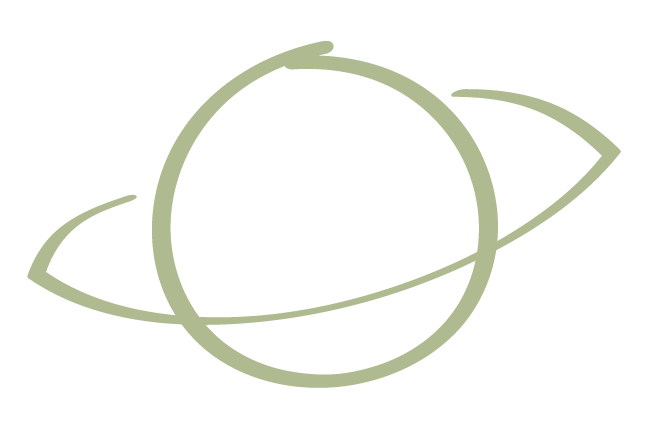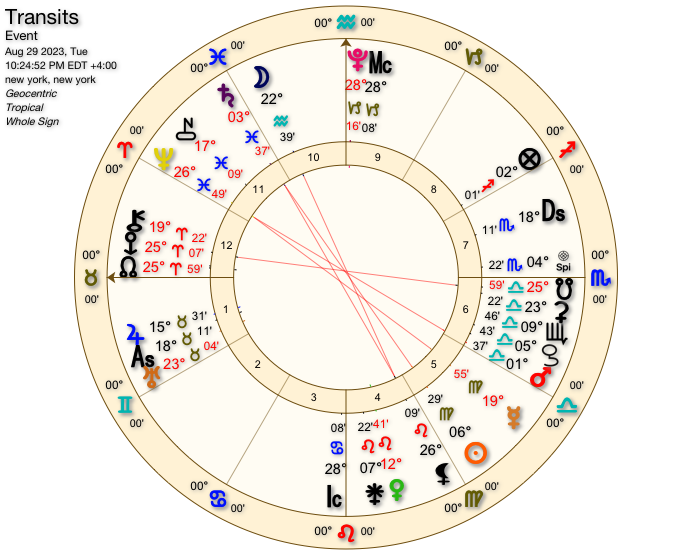Major Aspects in Astrology (Conjunction, Square, Opposition, Trine, and Sextile)
Aspects in astrology
For many of us who are delving deeper into astrology, aspects can feel really confusing. It took me a long time to get what they really are, and it probably would have clicked much sooner had I heard these lines in the chart referred to as ‘angles’ rather than aspects. That’s what aspects are – the geometric angles that planets make to each other. Aspects are depicted in an astrological chart as lines in the center of the chart, usually in different colors.
In order to understand aspects, we have to understand the chart as an actual physical thing. Your birth chart is a snapshot of how the planets were positioned in the sky at the time of your birth – it’s a physical map of the sky at the moment you were born. Here is a short video I made explaining the chart from that perspective. Think about how angles feel in geometry.
Aspects describe the ways in which different planets ‘influence’ one another and the relationship they have with each other. For example, you may be a Cancer sun, but if the sun was making a major aspect to Saturn when you were born, you may also embody a good amount of Saturnian energy, too. If that aspect is a ‘hard’ aspect, your Saturnian energy may feel a bit louder, and possibly more problematic.
There are five major aspects in astrology: conjunctions, squares, oppositions, trines, and sextiles. Conjunctions, oppositions and squares are considered ‘hard aspects.’ Trines and sextiles are considered ‘soft aspects.’ Hard aspects are generally considered to be more potent and more challenging. Soft aspects are less potent, but less challenging.
Conjunctions in astrology
Conjunctions in a chart, circled in pink
Conjunctions in astrology are when two planets are within 9º of each other — they are right next to each other in the sky.
Conjunctions represent an effortless melding of the energies and archetypes of the planets. They vary in their expression depending on the qualities of the planets involved, but they always bring the two planets together. Whether that ‘togetherness’ is a sweet hug or a a fist fight depends on what the planets are all about. Conjunctions involving a malefic planet, for example, can be fairly difficult. On the other hand, a conjunction between planets like Venus (a benefic) and the moon is typically pretty cozy and sweet.
Conjunctions involving outer planets and personal planets or angles feel so overwhelming that the people who have them in their natal charts are often afraid of the things associated with the planet. It’s like conjunctions between outer planets and personal planets feel like an unwanted invasion, something that surrounds you like an angry mob, a thick fog, an inescapable fire or flood. It can be hard to see the outer planet for what it is because we are so entirely immersed in it. But people with natal conjunctions to outer planets understand something about what their generation is wrangling with and have a unique opportunity t move the mission along. The problem is that it feels like those issues are coming from the inside, like you are the problem. You’re probably not.
The symbol for a conjunction in astrology: ☌
Oppositions in astrology
Oppositions in a chart (all of the red lines going from planet to planet)
Oppositions in astrology are when two planets are 180º from each other – they are sitting exactly across from one another in the sky. Oppositions are tense, hard, and electrifying aspects. They are said to carry an energy similar to Mars.
Oppositions are usually pretty challenging, but they also force a lot of growth and development over the long-term. Oppositions feel like the two planets involved have locked eyes from across the room. They are two planets staring each other down. That can be exciting (like sexual tension from really intense eye contact) or stressful (like when someone threatening is staring directly at you and there’s nowhere to turn).
Oppositions may also feel like a swinging pendulum, like we can only embody one of the planets at a time, or like something is constantly threatening the peace of the planets involved. Oppositions are often really activated by other people or outside events. For example, people with moon opposite Pluto can be very insightful to the point of being psychologically invasive, but it may not cause much of a problem until someone or something “triggers” the deep fear (a Pluto thing) that people who have that aspect associate with connection and comfort (a moon thing).
The symbol for an opposition in astrology: ☍
Squares in astrology
Squares in a chart (the red lines going from planet to planet)
Squares in astrology are when two planets are 90º from each other — they are making a right angle to each other in the sky. Squares are tense, hard aspects and are said to carry an energy similar to Saturn.
Squares conjure the image of two bulls locking horns, or two tectonic plates crashing into one another. Neither one is backing down. Both stand their ground. Squares are typically very internalized, involve an immense amount of activating inner pressure, and often catalyze action. Squares involving personal planets and angles are major parts of who we are. Other people may not recognize how major a square feels to an individual because they are felt so internally. Unlike oppositions, they require no outside activation. They are deeply embedded in the fabric of who we are.
For example, if you have Mars square Pluto, your feelings about and expression of Mars are tangled up in Plutonian fear, intensity, and extremes and you may feel more Plutonian than people think you are. It may also be hard to let Mars out because it feels so pressurized and internal.
Squares also represent conflicts of interest. They represent two conflicting parts of ourselves bashing heads and it can be very difficult to satisfy both, as their needs are in conflict with each other. However, if the two planets are of the same modality (as most squares are) it may be a good idea to really explore the nature of their modality to find the things they have in common. For example, if you have Venus in Sagittarius square moon in Virgo, both are mutable signs, so they are both interested in change and moving forward. How can that shared appreciation for forward motion bring your moon and Venus together?
The symbol for a square in astrology: □
Trines in astrology
Trines in a chart (all of the blue lines going from planet to planet)
Trines in astrology are when two planets are 120º from each other – they are essentially forming one leg of a triangle. Trines are said to carry an energy similar to Jupiter.
Trines are considered to be soft, harmonious aspects. They represent an effortless flow of energy between different planets. Trines are most often pretty nice; we are able to make the best of both of the planets involved. These are parts of ourselves that come together seamlessly, they are not in conflict with each other, and they communicate with each other easily; they speak the same language.
Trines can be really great, and sometimes offer a fantastic remedy for certain issues in a chart. For example, if you have your Libra sun trine your Aquarius Mars, this trine may even help make up for Libra’s stereotypical difficulty with Mars-related things like conflict and taking decisive action. Another example: when Mars is trine Mercury in transit, it is a good time to initiate difficult conversations, so long as we remain aware that words may come out a little sharper than we intended.
However, the “effortless” quality of trines can sometimes be problematic, particularly if things come too easily. Too many trines are sort of like gifted child syndrome — everything came so easily early on in life that you don't know what to do when you come up against obstacles. Without experiencing some amount of struggle throughout life, we are unlikely to learn the value of hard work and tenacity. People with a lot of trines in their natal charts may be gifted children who find themselves surprised that some things require a lot of long-term focus and work later on in life.
The symbol for a trine in astrology: △
Sextiles in astrology
Sextiles in a chart (all of the blue lines going from planet to planet)
Sextiles in astrology are when two planets are 60º from each other. They, too, are considered to be soft, harmonious aspects. Sextiles are said to carry an energy similar to Venus.
Sextiles are generally the weakest of the major aspects—they aren’t as profoundly ‘felt’ as the others are—but they are supportive. Two planets in sextile to one another have tools that can help each other out, like a neighbor giving you a cup of sugar when you’ve run out.
Sextiles are nice in the way that we can turn them on and off more easily than any of the other major aspects. They are not always in your face, like a friend you don’t see every day but who is always there when you need something.
The symbol for a sextile in astrology is an asterisk.
Orbs in astrology
In astrology, an ‘orb’ is the number of extra degrees added onto or subtracted from an exact aspect. Exact aspects have a 0º orb. I use up to a 9º orb for every type of major aspect. Different astrologers may use different orbs.
Conjunctions: Two planets are considered conjunct when they are within 9º from one another in the sky. An exact conjunction is when two planets are 0º from each another. Conjunctions typically occur when planets are in the same sign, but there can be exceptions.
Oppositions: Two planets are considered in opposition to one another when they are anywhere from 171º to 189º from one another in the sky. An exact opposition is when two planets are exactly 180º from each other. Oppositions typically occur when the planets are in signs of the same modality, but there can be exceptions.
Squares: Two planets are considered to be square one another when they are anywhere from 81º to 99º from one another in the sky. An exact square is when two planets are exactly 90º from each another. Squares typically occur when the planets are in signs of the same modality, but there can be exceptions.
Trines: Two planets are considered to be trine one another when they are anywhere from 111º to 129º from one another in the sky. An exact trine is when two planets are exactly 120º from one another. Trines typically occur when the planets are in signs of the same element (also known as triplicity), but there can be exceptions.
Sextiles: Two planets are considered to be sextile one another when they are anywhere from 51º to 69º from one another in the sky. An exact sextile is when two planets are exactly 60º from each another.







